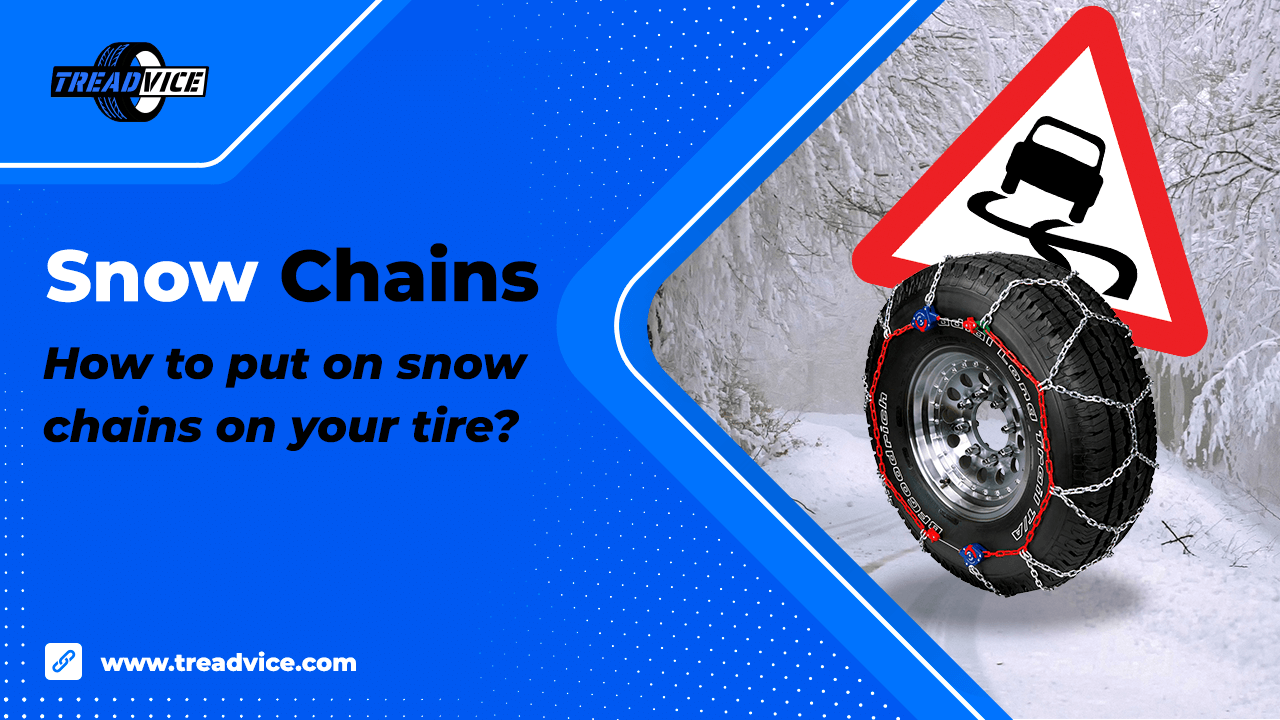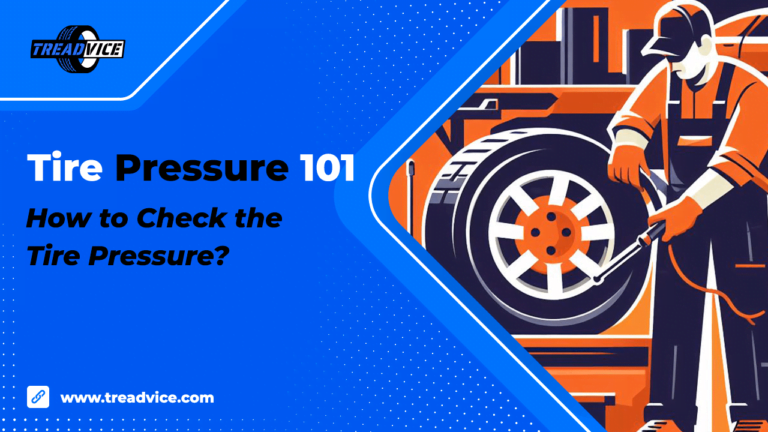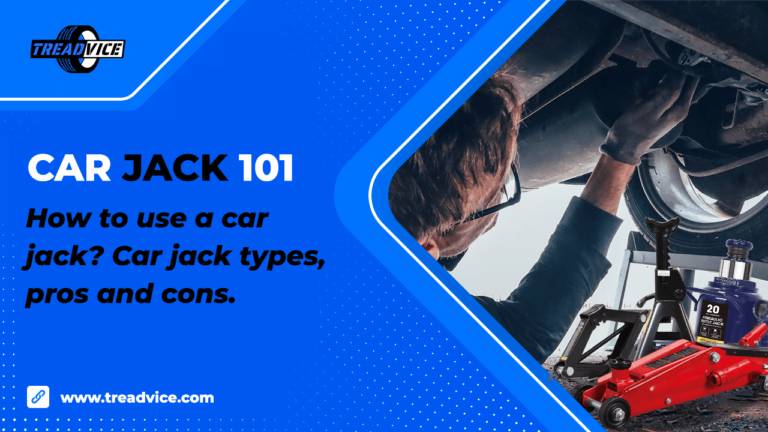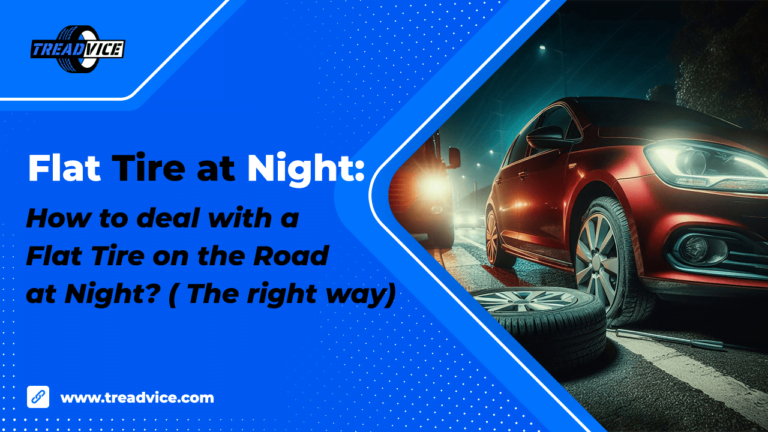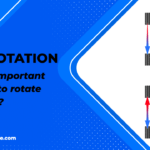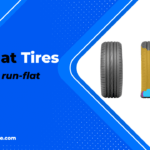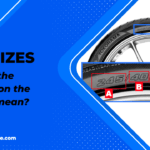Imagine you’re on a winter road trip, heading up a mountain. As you ascend, the weather takes a turn for the worse. Heavy snow blankets the road, turning it into a slippery, icy surface, while the plummeting temperatures make driving exceptionally challenging. However, in this precarious situation, snow-chaining your tires can save the day.
Snow chains are a must-have tool for winter driving. Their job is pretty simple but incredibly effective. They’re essentially a bunch of metal links that you put on your car’s tires, mainly in the tread area which makes them work like magic.
In this article, we’ll discuss what snow chains are and how they work.
Table of Contents
What are snow chains?
Snow chains, also referred to as tire chains or snow tire chains, are devices constructed with metal links that you attach to your vehicle’s tires.
Snow chains are purpose-built to enhance traction and grip on snowy and ice-covered roads. By doing so, they empower your vehicle to maintain better control and stability in slippery conditions. Snow chains are especially common in regions prone to heavy snowfall and icy weather, primarily during the winter season. Their use is crucial for enabling vehicles to navigate through challenging terrains and uphold safe driving conditions, even in the harshest of winter weather.
How do snow chains function?
Snow chains are a tool that is specially used for winter driving. They work by providing better grip and control on snowy and icy roads.
Snow chains are metal links attached to your car’s tires, mainly in the tread area.
How does it work? When you’re driving on snowy or icy roads, these metal links create a rough surface that digs into the snow and ice, giving you a strong hold on the road. This stops your tires from slipping or spinning, which is a common headache in slippery winter conditions.
Snow chains do more than just prevent slipping. They also make steering and braking safer. By giving you better traction, they reduce the risk of skidding and losing control. This means you can confidently navigate tricky turns and stop safely when needed. This control is especially important when tackling steep hills, as it prevents your vehicle from sliding backward.
Snow chains also help distribute your vehicle’s weight more evenly across the tire’s surface. This even weight distribution is like having your tires stay on top of the snow, preventing them from sinking in and getting stuck.
In simple concept, snow chains are your go-to for safer winter driving. They lower the risk of accidents and improve your control, especially in bad weather.
How to put on a snow chain?
For beginners, putting on snow chains can be challenging, particularly in cold, slippery conditions. To make it easier, start by reading the instructions carefully and practice in ideal, dry conditions before you need them in snowy or icy situations. Consider using snow chains with features like self-tensioning or built-in tensioners, and make sure you have the right tools.
Prerequisites:
To put on snow chains, you’ll need:
- Snow chains in the correct size for your tires.
- Work gloves.
- Kneeling mat or towel for comfort.
- A flashlight for low-light conditions.
- Tensioning devices if your chains have them.
Step-by-step guide on how to put on a snow chain:
- Size Check: Before you start, ensure that you have the correct size of snow chains for your vehicle. You can find the appropriate size in your vehicle’s owner’s manual or on the sidewall of your tires.
- Safe Parking: Park your vehicle in a safe and level area, ideally on dry ground. Ensure that you are well away from traffic, and if possible, use hazard lights to alert other drivers.
- Chain Prep: Unroll the snow chains beside your vehicle. Make sure they are untangled and lay them flat on the ground.
Important notes:- If your chain has cross hooks, make sure they are facing away from the tire as they can damage your tire!
- If your chain is equipped with cams, make sure they are facing on the outside of the tire and they are in open / the most extended position!
- Drape & Center: Starting with one of the drive wheels, typically the front wheels for front-wheel-drive vehicles and the rear wheels for rear-wheel-drive vehicles, drape the chain over the top of the tire, ensuring it’s centered and positioned evenly.
- Optional: Attach the ends of the chain losely, so it won’t come off in the next step.
- Vehicle positioning: Get in your vehicle and gently drive your vehicle backwards/forwards so you can secure the connection. This can make it easier to attach them to the tires.
- Secure Connection: Secure the ends of the chain together. Most chains come with fasteners, which could be a hook, clasp, or a tensioning device. Ensure the chain is snug but not overly tight.
- Tension Control: Some chains come with built-in tensioners or separate tensioning devices. Use these to tighten the chains. They should be snug against the tire, but not overly tight, as they need some flexibility to work correctly.
If you tensioned the chains properly, you should be able to fit only your fingertips between the cross chain and the tire. - Extra step for Four-Wheel Setup: If your vehicle is four-wheel-drive or all-wheel-drive, repeat the process for the other set of drive wheels.
- Adjustments: After installing the chains, drive your vehicle forward and backward for a short distance to ensure the chains are properly centered and securely in place. Adjust if necessary.
- Test Drive: Once the chains are secure, drive at a slow, steady speed. Be cautious, and avoid sudden maneuvers, such as sharp turns or abrupt braking, as snow chains can impact your vehicle’s handling.
- Periodic Checks: During your trip, it’s essential to stop periodically and check the chains to make sure they remain tight and secure. Chains can loosen over time, especially if you’re driving on uneven or icy terrain.
Remember to practice installing and removing snow chains before you encounter winter weather. Familiarity with the process can make it much easier when you’re on the side of a snowy road.
Always consult your vehicle’s owner’s manual for specific instructions related to your vehicle.
How to choose the correct snow chains for your tires?
- Consult your vehicle’s manual for recommendations.
- Note your tire size from the sidewall.
- Ensure adequate clearance around the tires.
- Select the appropriate chain size.
- Consider chains with built-in tensioners for convenience.
- Review local regulations.
- Read user reviews for recommendations.
Snow chain suggestions:
Easy To Install – for Passenger Cars and SUVs
Swift Installation, Swift Removal: Who said installing tire chains has to be a chore? The SCC – Peerless Auto-Trac defies that notion. In just minutes, you can effortlessly equip your vehicle for the winter journey ahead. Plus, removing them is just as quick and easy, letting you get back to the road in no time.
The Diamond Touch for Superior Traction: Ever dreamt of a smoother ride through winter wonderlands? The diamond pattern cross chain of Auto-Trac not only provides superior traction but ensures your ride remains smooth even in challenging conditions. It’s not just about getting through; it’s about getting through with style.
Patented Ratcheting Tightening System: No more struggling with tensioners! Auto-Trac features a patented, ratcheting tightening system that automatically adjusts while you drive. Connect the inside cable, attach the self-tighteners, and you’re ready to roll. No extra tensioners needed – it’s that simple.
Manganese Alloy Magic: Auto-Trac’s cross member links are crafted from manganese alloy steel, making them shorter, narrower, and lighter than conventional counterparts. This not only reduces ‘fly-off’ during operation but increases gripping points, providing you with a secure and durable solution for your winter adventures.
Class ‘S’ Clearance Compatibility:
Whether you’re driving an SUV, a pickup truck, or a standard passenger car, Auto-Trac meets Class ‘S’ clearance requirements. It stands tall, matching the capabilities of most ‘Z’ cable products, all thanks to its highly effective patented tensioning system.
American Craftsmanship, Global Excellence: Manufactured by Peerless Chain, a trusted name in the industry, and proudly made in the USA, the SCC – Peerless Auto-Trac Tire Traction Chain is a testament to American craftsmanship and global excellence. It’s not just a tire chain; it’s your key to mastering winter roads.
Speed Rating: Maximum recommended 30 mph
Easy To Install – for light trucks and SUVs
It is basically a variation of the traction “SCC – Peerless Auto-Trac Tire Traction Chain” described above. Check the details above.
Easy To Install – for trucks and SUV
CAM Tightening System: Bid farewell to the hassle of tensioners! The Quik Grip Light Truck Chain features a built-in CAM tightening system, making separate tensioners a thing of the past. Tightening is effortlessly done with the provided CAM tool, included in every package. It’s a game-changer that simplifies the installation process, ensuring that you spend less time grappling with chains and more time enjoying the journey.
Durable Design for Lasting Traction: Crafted from extra-durable manganese alloy steel with a yellow chromate finish, Quik Grip doesn’t just offer traction; it promises durability. The long-wearing square link cross chains contribute to its robust design, making it a reliable companion in challenging terrains.
Easy Installation, Every Time: Equipped with step-by-step instructions and the essential CAM tool, the Quik Grip Light Truck Chain ensures a straightforward installation process. No need for additional tensioners – just follow the instructions, use the CAM tool, and you’re ready to hit the road.
An Alternative to Cable Chains: For those who seek an alternative to cable chains without compromising on traction, Quik Grip is the answer. It provides optimal traction for your light truck, making it an excellent choice when clearance is not a primary concern. It’s the balance between performance and ease of use that sets Quik Grip apart.
Downside: While Quik Grip excels in many aspects, it’s essential to acknowledge that it does not meet S.A.E. Class “S” clearance requirements. However, for those who prioritize traction and durability, Quik Grip proves to be a worthy companion on winter journeys.
Speed Rating: Maximum recommended 30 mph
Inexpensive and relatively easy to install snow chains – for Passenger Cars and SUV
Dedicated to radial tires: Originally designed to preserve sidewall wear on radial tires, Radial Chain was the pioneer, the first real brand name in cable chain winter traction products. Its inception marked a turning point in winter driving, and today, it continues to be a market leader, maintaining the same consumer-friendly features that propelled its rapid rise to popularity.
Class “S” Clearance Compliance: Meeting S.A.E. Class “S” clearance requirements, Radial Chain aligns with the highest standards of safety and performance.
Longevity: Crafted with all-steel construction, instead of traditional steel rollers. This innovative design ensures a longer service life, as these coils resist flattening that commonly plagues traditional rollers.
Tried and Tested Across the Globe: With a history of performance testing from the frosty terrains of Alaska to the snow-covered landscapes of Switzerland, Radial Chain has earned its stripes. The tire application chart includes every original equipment tire sold in North America, showcasing its versatility and compatibility across a wide range of vehicles.
No tensinoer required: Chain tensioners SHOULD NOT be used, simplifying the installation process and ensuring a hassle-free experience.
Speed Rating: Maximum recommended 30 mph
Inexpensive snow chains – for Passenger Cars, SUVs
Quality on a Budget: Crafted from high-quality materials, Barbella’s snow chains stand tall against heavier loads. Each chain boasts thickness for a robust grip, wear resistance, and an impressive anti-skid ability, ensuring smoother and safer drives through winter wonderlands.
All-Around Traction Marvel: Surpassing conventional tire chains or cables, Barbella Tire Traction Chains promise greater durability and superior all-around traction performance. It’s a budget-friendly solution that doesn’t skimp on performance.
Ladder-Type Innovation: The ladder-type snow chains pattern is not just about aesthetics; it’s a design choice that reduces weight without compromising strength. This translates to easy installation, making your winter preparations a breeze. The D-profile crosspieces provide exceptional grip on ice, snow, and soft hail.
Built to Last: Crafted from manganese alloy steel, these chains boast reliability in every snowy scenario. The thickened alloy U-shaped double hook claws, M-Type lock tab, and wire rope locking device contribute to a design that’s not only budget-friendly but dependable for your winter journeys.
Speed Rating: Maximum recommended 20 mph
Practical Price: The Shur Grip Z class S cable chains, designed for Passenger & SUV use, bring Z performance to the everyday consumer at a moderate price point.
Reliable All-Around Traction: The Z® Passenger & SUV chain delivers better all-around traction performance compared to conventional tire chains or cables. Its diagonal crossmember pattern ensures outstanding traction and durability, making it a reliable companion for winter drives.
Durability in Simplicity: The Shur Grip Z chain is designed to withstand winter challenges, and its compatibility with anti-lock brakes, traction control, all-wheel drive (AWD), and other control systems adds a layer of sophistication without sacrificing simplicity.
Class “S” Clearance Compliance: Meeting S.A.E. Class “S” clearance requirements, this chain caters to vehicles with limited clearance, ensuring a precise fit without compromise.
Tensioner requirement: The usage of chain tensioners is required but thoughtfully there is a rubber tensioner included already in the package.
Speed Rating: Maximum recommended 20 mph
Inexpensive but might take longer to install – for SUVs, Trucks, RVs
Durable material: Crafted from high-quality manganese steel, these snow chains are designed to handle heavier loads. The thick chains provide a strong grip, wear resistance, and ice-breaking capabilities, ensuring a smoother and safer driving experience in challenging winter conditions.
Adjustable Size Convenience: The adjustable feature allows effortless fitting to most standard sizes of alloys or steel wheels on cars, vans, and RVs. With compatibility for tire widths ranging from 215mm to 285mm, these chains offer a versatile solution for most car tires.
Non-Slip & Wear-Resistant Design: Equipped with a strong ice-breaking grip, these chains tackle various environments with ease. The inclusion of a protective shell on the tightener, an alloy roller automatic tightening device, and a thickened TPU anti-skid pad adds to the chains’ durability and usability.
Downsides:
- Not Compatible with Traditional Steel Rims: Despite the simplicity and practicality, it’s essential to note that these chains are not compatible with traditional steel rims, presenting a downside for those with specific wheel configurations.
- Might take longer to installer as each pad needs to be installed individually.
Speed Rating: Maximum recommended 25 mph
Advantages of Snow Chains
Snow chains are a valuable investment for anyone who faces winter driving challenges. Whether you live in a region with heavy snowfall or plan to travel through winter conditions, snow chains are an effective and versatile solution to help you reach your destination safely.
There are many advantages we get from snow chains such as:
- Improved Traction: Snow chains provide exceptional traction on snow and ice-covered roads. The metal links dig into the snow and ice, offering better grip, which reduces the chances of your tires slipping or spinning.
- Better Control: With snow chains, your vehicle is more responsive to steering and braking. This enhanced control allows you to navigate challenging conditions more safely.
- Enhanced Safety: The improved traction and control snow chains provide contribute significantly to safer winter driving. They reduce the risk of accidents caused by skidding or losing control.
- Versatility: Snow chains are compatible with various types of vehicles, including cars, trucks, and SUVs. This versatility makes them a practical solution for different situations and vehicles.
- Effective in Extreme Conditions: In extreme winter conditions, where other traction devices like snow tires or all-wheel drive may struggle, snow chains often remain effective. They’re a reliable choice when you encounter deep snow, icy terrain, or steep inclines.
Disadvantages of Snow Chains
While snow chains provide significant advantages for winter driving, they also come with some disadvantages and considerations that users should be aware of.
Such as:
Challenging Installation: Putting on snow chains can be a time-consuming and physically demanding process, especially in cold and wet conditions. It may require you to lie on the ground or kneel in the snow.
Road Damage: Using snow chains on roads that are clear or only lightly covered with snow can damage both the chains and the road surface. The metal links can wear down the road and create ruts or grooves.
Speed Limitations: Snow chains can limit your driving speed. They affect your vehicle’s handling and ride comfort, and driving too fast can be unsafe.
Noise and Vibration: Snow chains can be noisy and create vibrations while driving. This noise and vibration can be uncomfortable, distracting, or annoying for you and other road users.
Limited Use on Certain Roads: Some roads, particularly those with steel bridges, prohibit the use of snow chains to prevent road damage. In such cases, you may need to rely on alternative traction devices like snow socks or snow tires.
Frequently Asked Questions (FAQs)
On average, good-quality snow chains can last for approximately two to three seasons if they are used moderately and maintained properly.
The lifespan of snow chains can vary significantly based on factors such as their quality, frequency of use, road conditions, proper installation, maintenance, size and fit, and their material and design.
High-quality chains may last longer than cheaper alternatives, and the road conditions and frequency of use can impact their durability. Proper installation, regular maintenance, and choosing the right size and fit for your tires are essential for extending their life. It’s important to inspect your snow chains regularly for wear and damage and replace them when necessary. The longevity of snow chains can vary, and following the manufacturer’s guidance is advisable for specific information on their expected lifespan.
Snow chains, also known as tire chains, are devices made of metal links that you attach to your vehicle’s tires. They work by providing enhanced traction on snowy and icy roads. The metal links create a rough surface that grips the snow and ice, offering better control and preventing tire slippage.
Snow chains are essential when you’re driving in heavy snow or on icy roads. They provide added traction and control, making them ideal for winter weather conditions, especially in hilly or mountainous areas.
Consult your vehicle’s owner’s manual or check the tire size on the sidewall of your tires. Choose snow chains that match these specifications to ensure a proper fit.
Snow chains can be used with most vehicles, including cars, trucks, and SUVs. However, some vehicles may have limited clearance or restrictions, so it’s crucial to review your vehicle’s manual and local regulations.
While it’s not necessary to install snow chains on all four tires, it’s generally recommended for optimal traction and control, especially in extreme conditions. However, if your vehicle is two-wheel-drive, you can install them on the drive wheels.
It’s recommended to drive at a slow and steady speed when using snow chains. Excessive speed can lead to reduced control and increased wear on both the chains and tires. Always follow posted speed limits and adjust your driving accordingly.
Snow chain installation can be challenging, particularly in cold and slippery conditions. Practice installing them in ideal conditions before you need them in winter weather. Some chains come with features like self-tensioning or built-in tensioners for easier installation.
It’s not advisable to use snow chains on clear or dry roads, as they can cause damage to both the chains and the road surface. Remove them once you’re no longer driving on snow or ice-covered roads.
Yes, there are alternatives like snow socks and winter tires. Snow socks are fabric-based covers that provide traction, and winter tires are specially designed for cold weather. The choice depends on your driving needs and conditions, so consult with a tire expert to determine the best option for your situation.
If you tensioned the chains properly, you should be able to fit only your fingertips between the cross chain and the tire.
Conclusion
Snow chains give you great traction and safety on snowy roads. But, they can be a bit tricky to put on, noisy when you drive, and sometimes scrape the road. So, choose wisely based on what’s most important for your winter travels.
